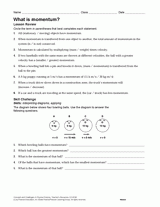You know what the word momentum means, right? There are all sorts of situations in which momentum comes into play, and you encounter them daily. When you whack a ball with a tennis racket, you're transferring momentum from the racket to the ball, moving the ball in a certain direction.
If you run fast down a hill and find it difficult to stop at the bottom, you say you had a lot of momentum behind you. Momentum, simply put, is the mass of a moving body times its velocity, or speed in a specific direction.
If friction is not a factor, momentum will pass from one object to a second and then to a third at a constant rate. The total amount of momentum transferred would remain constant from the first object to the last.
In the physics experiment described here, you'll apply the concept of momentum using marbles, meter sticks, a stopwatch and different surfaces. You can conduct the experiment on surfaces such as a hardwood floor, linoleum, cement, indoor/outdoor carpeting, plush rug or any other flat, horizontal surface on which a marble can roll.
What you'll do is observe the momentum and calculate the velocity of moving marbles. Take a guess at what you think will occur on various surfaces as momentum is transferred from one marble to another. The formula to calculate velocity is shown below.
Momentum is the mass of a moving body times its velocity. It can be transferred from one object to another.
- mvi × m"v"i = mvf × m"v"f
- m = mass of the first object
- vi = initial velocity of the moving object
- m" = mass of the second object
- v"i = initial velocity of the second object
- vf = final velocity of the second object
- v"f = final velocity of the second object
Begin your observations by taping two meter sticks to a floor at a width just wide enough for one marble. Place two marbles in the middle of the "track" 10 cm apart from each other. Flick the first marble so it hits the second one. How does the velocity of the first marble change? What happened to the second marble?
Next, put two marbles in the track next to each other. Take a third marble and set it about 10 cm from the others. Flick the third marble at the other two. What happened to each marble?
Could you tell that momentum was being transferred? Repeat the procedure on several different surfaces. Does the material from which the surface is made affect the velocity of the marbles? If so, why do you think?
Use the preceding formula, a stopwatch, and a ruler to measure the distance the marbles rolled when momentum was transferred to them. Calculate the velocity of the marbles before and after their collisions on different surfaces, both smooth and on rugs or carpeting. Doing so will give you mathematical data to support your hypothesis.






